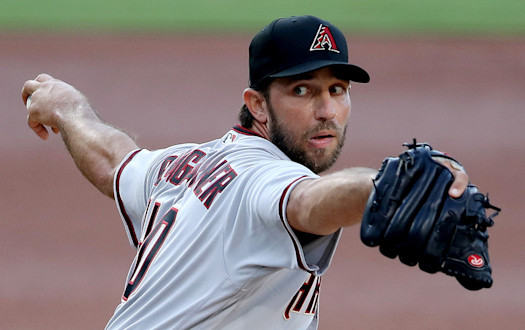Madison Bumgarner Made History, With an Asterisk

On Sunday evening, Madison Bumgarner threw a complete game shutout against the Braves without allowing a base hit. He had gone through seven hitless innings three times in the past but gave up hits in the eighth inning on each of those occasions. Sadly, at least in the eyes of MLB’s brass, he still hasn’t thrown a no-hitter just yet. He’ll take the mound tonight with a chance to (not quite) match one of baseball’s unbreakable records: back-to-back no-hitters.
This unfortunate turn of events is because of one of Rob Manfred’s new institutions – the seven-inning doubleheader. This was the second game in that set (embarrassingly, the Braves only managed one hit between both games), and because Bumgarner technically only threw seven no-hit innings – even though it was a complete game – he won’t be credited with the no-hitter. The ruling stems from a 1991 decision in which then commissioner Fay Vincent declared that no-hitters must span at least nine innings. Madison Bumgarner is a vocal traditionalist who has made it known he is opposed to adopting the universal DH on multiple occasions, so having a no-hitter robbed from him in this fashion will probably not sit right in his mind.
If the game had lasted a full nine innings, would he have reached the finish line? We’ll never know for sure, but clearly all the Braves’ hitters were lost at the plate Sunday; their lone hit across two games set a new record for fewest hits ever over the course of a doubleheader. What stings the most about this is that by ruling his effort wasn’t a real no-hitter, MLB basically admitted that seven-inning games aren’t legitimate. If they don’t count in the record books, then why should they count in the standings? The effort also counted as a complete game, which seems altogether inconsistent. It remains to be seen if the seven-inning doubleheader will stick around forever since it was first introduced to help make up for games cancelled from positive COVID-19 tests last year – as was the extra-inning rule where a runner starts out on second.
The only batter to make it to first base safely against Bumgarner on Sunday reached on a throwing error from Diamondbacks’ shortstop Nick Ahmed, and the baserunner was promptly dispatched on a ground-ball double play. Bumgarner faced the minimum possible hitters in the game, finishing with 98 pitches and seven strikeouts. “Feels good,” Bumgarner said during a postgame interview on the Diamondbacks’ broadcast. “I want to thank the shadows in Atlanta — they helped me out a good bit. That’s pretty awesome. And I want to thank (commissioner) Rob Manfred for making these seven-inning games… I didn’t give up any hits today. I’m not in control of how many innings we’re playing.”
Bumgarner’s rotation mate, Zac Gallen, also threw a complete game in his one-hit shutout of the Braves prior to the non-no-hitter. Gallen commented in his own postgame interview about giving up the single to Freddie Freeman that: “It wouldn’t have counted, so that makes me feel better that it wasn’t actually a no-hitter anyway.” Just a few hours later, that same exact scenario ironically befell Bumgarner. He’s the first pitcher to work seven no-hit innings under the doubleheader rules that have been in place since the start of the 2020 season, so even if it doesn’t retroactively go down as the 308th no-hitter in major league history, history was made regardless.
This was also a sorely needed strong start from Bumgarner, as his ERA before the game sat at an ugly 8.68. In the off-chance that the ruling of the game is retroactively changed (or you just feel in your heart that he deserves it), Bumgarner would have the third no-hitter of just this month after Joe Musgrove and Carlos Rodón got theirs.
One game from history stands out as a comparable instance of a pitcher throwing a no-hitter without being credited for one. In this instance, however, it went down as a combined no-hitter. On June 23, 1917, Ernie Shore of the Boston Red Sox retired all 26 of the batters he faced despite not starting the game at all. Babe Ruth actually started that game, back when he was a pitcher, and walked the leadoff man before throwing punches at the umpire over balls and strikes. You read that right.
Ernie Shore entered the game after Ruth was ejected and, after baserunner Ray Morgan was caught stealing, retired the remaining 26 batters while recording just two strikeouts. The game was certainly played differently back then!












